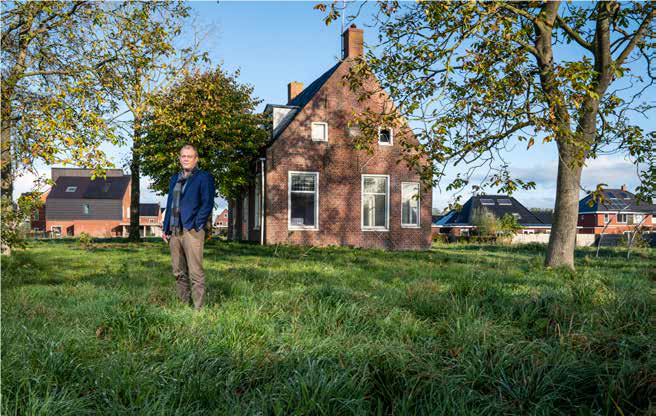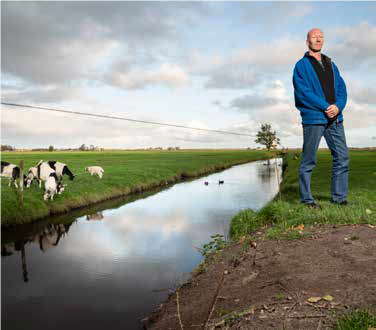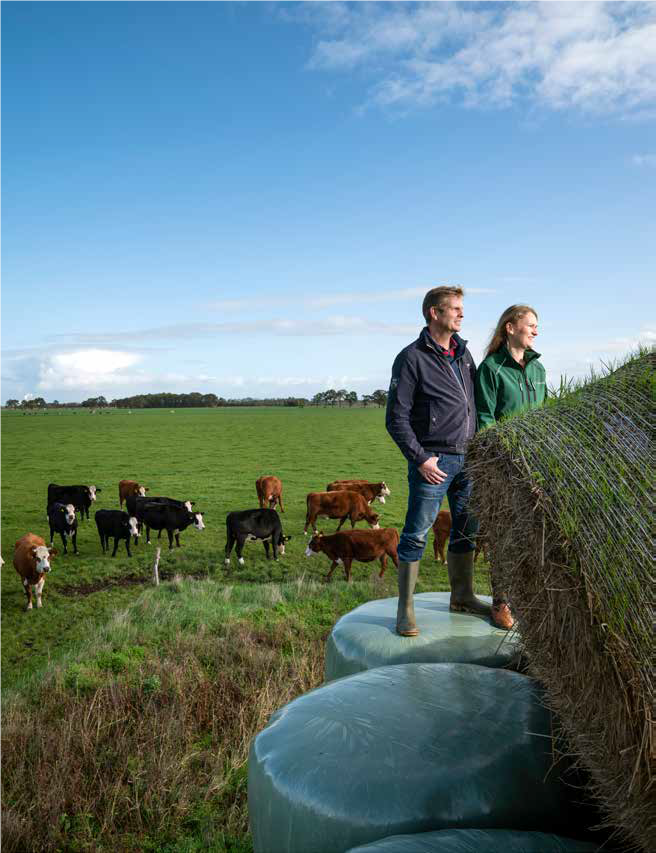The Dutch ministry of Agriculture, Nature and Food Quality does not have a blueprint for the circular agriculture it aims at. The approach is to be developed in regional ‘innovation workplaces’ where farmers, nature-lovers and scientists work together. It is starting to take shape in the Northern Netherlands. Reporter Albert Sikkema went to have a look.
Maurits Tepper and Jessica
Maurits Tepper, joint owner with his wife Jessica of Eytemaheert farm, is quickly building a ‘skybox’ in honour of the big shots from WUR and the Agriculture ministry who will be visiting the farm tomorrow to discuss a research programme at this brand new WUR experimental farm.
They’ll be able to survey his Groningen Blaarkop cows from this raised platform in the shed.
We are in Leutingewolde, at the northernmost tip of the province of Drenthe. Eytemaheert borders a lake, the Leekstermeer, and a Natura 2000 reserve, the Onlanden. It’s a vulnerable area in terms of the nitrogen problem, but Tepper is keeping his cool. His farm is to be a showcase example of a livestock farm with a closed manure and nitrogen cycle.
Processing grass clippings
Eytemaheert has 500 Groningen blaarkop cows that produce meat which the Teppers sell directly to consumers through a webshop. The cows are entirely grass-fed and the farm buys no feed or manure from elsewhere. But it does process grass clippings from the nearby nature reserve into the fertilizer bokashi. ‘The nitrogen-rich clippings from the nature reserve compensate for the nutrient loss from the farmland due to grazing cows,’ says Tepper. He would like further research done on bokashi, a mixture of grass clippings, chalk, clay and micro-organisms that break down the cell structure of the hay. ‘Together with Staatsbosbeheer (the state forest service, ed) and Natuurmonumenten (a nature conservation organization, ed), we want to look at how other farmers could make use of this bokashi too. That is not possible at present because if you transport it more than five kilometres, it comes under waste matter legislation and farmers must keep a record of it.’
The blaarkop cows are entirely grass-fed and the farm buys no feed or fertilizer from elsewhere
This research will probably be done because last summer, Eytemaheert became one of Wageningen University & Research’s experimental farms for nature-inclusive circular agriculture. Martin Scholten, director of the Animal Sciences Group, wants to explore new opportunities for putting circular agriculture into practice, he explains on Eytemaheert’s website. Tepper and his wife will still own the farm, but they are keen to have the nitrogen cycle quantified by Wageningen researchers. And they intend to start milking their blaarkop cows, so that they become ‘dual-purpose’ cows producing both milk and meat.
Nature 2000
Tepper thinks the blaarkop cows can produce about 5000 litres of milk per year – half of standard production levels. He wants to make cheese with some of it. Wageningen could also study this business model with dual-purpose cows. ‘This is a good business model to use near Nature 2000 areas,’ thinks Tepper. His guess is that his farm does not produce much ammonia, because he doesn’t import any nitrogen in the form of feed concentrate and artificial fertilizer. In fact, with the bokashi he actually transports nitrogen out of the nature reserve. What is more, the cows spend most of their time out in the fields, so their droppings and urine do not get mixed and no ammonia is formed that way. He is also thinking about how he can increase biodiversity on the land using mixed grass and clover, and creating hedgerows that produce hazelnuts, thus providing food and nature at the same time.
The representatives of the ministry and WUR are coming tomorrow to consult Tepper about the research programme at the farm that is aimed at finding out what effect his farming system has on biodiversity and soil life, and what effect the bokashi has on his nitrogen cycle. Tepper: ‘We must start measuring and finding out if it’s any good.’
Malting oats
We take a walk into the field behind the farmhouse. Maurits and Jessica Tepper are entrepreneurs who like to try out new things. Last summer they sowed a hectare of oats of an ancient variety that is less prone to diseases and pests. They are going to have the oats malted so they can make an oat beer for the local market. And next season, they want to grow one hectare of potatoes to sell directly to consumers through their webshop. They also want to hire a butcher to slaughter the blaarkop cows on the farm. ‘We sell directly to the consumer at a fair prize, and that’s how we make a profit.’

Hans Bergsma
Hans Bergsma, director of the Westerkwartier regional cooperative, is sitting in an office in Noordhoorn with four law students from the Hanze University of Applied Sciences in Groningen. They are poring over a folder that describes the key features of The Food Factory. The food suppliers are listed on the left-hand flap: livestock farmers, arable farmers and horticulturalists from the region. Their clients are listed on the right-hand flap: hospitals, care institutions, schools and restaurants in Groningen. In the centre is the food factory, which is going to slaughter animals, process food and make meals. A regional food chain in the making
The task of the law students is to figure out how participants in The Food Factory can arrange for intellectual property rights. The investors in the factory, including the regional cooperative, a project developer and processors of food and waste streams, contribute their knowledge of processes and their patents. The law students have to work out what price to put on these things.
Higher price
The Westerkwartier regional cooperative was started at the end of 2013 by an agricultural nature association of about 500 farmers, Staatsbosbeheer and a vocational training college Terra Groningen. Since then the Rabobank and an energy cooperative have joined too, says the director of the cooperative Bergsma. The aim is to find new business models for farmers in the Westerkwartier. Bergsma thinks The Food Factory can offer farmers in the regional chain 10 to 20 per cent higher prices, starting with 50 to 70 farmers who are going to supply food to hospitals and care providers in Groningen. Planning permission for The Food Factory, to be built near Leek, has already been applied for.
The Westerkwartier is farmed by conventional farmers who are looking for alternatives to the export-based business model, says Bergsma. ‘At the same time, we want to restore the relationship between farmers and the villages. So a transparent regional chain through which consumers in Groningen know where their food is coming from fits the bill.’
Wageningen specialists
Once the regional food chain is established, Bergsma wants to further develop circular agriculture with WUR’s help. ‘Within the regional cooperative, livestock farmers, arable farmers and horticulturalists are now talking to each other about things like how they can use each other’s waste streams. This means they encounter the issues around CO2 and nitrogen. I hope Wageningen specialists can tell us how they can best avoid harm to the climate and nature.’
Bergsma wants to collaborate on this with the Fjildlab in nearby Buitenpost, where a local association, Noardlike Fryske Walden, is working on circular agriculture with Wageningen.
The farmers are looking into how they can use each other’s waste streams

Albert van der Ploeg
Albert van der Ploeg, a Wageningen alumnus, has a small business with beef cattle and sheep in the north-east of Friesland, but today he is at a meeting in the Fjildlab, the innovation workplace for circular agriculture in North-eastern Friesland which he heads. He is also chair of the Noardlike Fryske Walden association, in which about 800 farmers and individuals collaborate on agricultural nature management and landscape restoration in this bocage landscape.
The farmers want to manage a small-scale landscape with hedgerows, field birds and biodiversity, says Van der Ploeg. The innovation workplace has eight expertise circles in which farmers can exchange knowledge on topics such as the use of manure and sustainable soil management.
Wageningen is closely involved in this Fjildlab. Researcher Durk Durksz is the project leader and Ingrid van Huizen, who was director of the Fryske Walden association for years, is now Wageningen’s circular agriculture programme manager for the Northern Netherlands. In this capacity, she finds researchers in Wageningen who can answer questions coming from the region. And not just in Friesland, she adds. ‘We want to find answers together with Eytemaheert and the Westerkwartier Regional Cooperative too.’
Human faeces
‘Our starting point for circular agriculture is the vision of WUR professor Imke de Boer,’ Van Huizen continues. ‘She wants us to use plant-based food solely for human consumption, and to feed livestock on grassland and waste streams. The farmers in this region have been working on circular agriculture for years. In the Fjildlab expertise circles, we are looking at the research needs of these farmers. We want to bring in the relevant scientific knowledge. One example is a project we have submitted on the use of human faeces in agricultural cycles.’
We want to research how farmers can make use of human faeces
Van der Ploeg is aiming at an agricultural transition. ‘The farming system no longer matches the demands of our society,’ he says, thinking of the nitrogen and manure issue and the fall in the numbers of insects and field birds. ‘We are looking for changes at the system level.’
Just like Eytemaheert, the Fjildlab wants to document the manure and nitrogen cycles of dairy farms and experiment with fertilizers such as bokashi and sewerage sludge. Van der Ploeg also wants to organize a closed manure cycle between livestock and arable farms, and to make use of waste streams from potato and beet farms in the region. For the nature management side, he relies on the scope for experimentation in the European Agricultural Policy.
Nature-friendly
Farmers can get grants for creating nature-friendly field edges and hedgerows. Van der Ploeg expects that Wageningen will contribute knowledge of biodiversity and landscape to this process. Ecological landscape management requires a business model, adds Van der Ploeg. ‘If you want cheap food, you get the monotonous landscape that goes with it, poor in biodiversity. If you want field birds, insects and a rich soil life, you’ve got to do something to get it, as a farmer. So the government must subsidize farmers for that. There’s nothing odd about that, because Staatsbosbeheer and Natuurmonumenten get government subsidies for nature management too – they are in the same boat as the farmers.’
| SO, WHAT IS CIRCULAR AGRICULTURE, AGAIN? |
|---|
| The cabinets wants the agriculture sector in the Netherlands to make a transition to circular agriculture by 2030. It wants an agriculture sector that: – contributes to closing the cycle, cutting emissions and reducing biomass waste in the food system; – strengthens the socio-economic position of farmers in the chain; – contributes to addressing climate change in line with the Climate Agreement; – makes the countryside more attractive and dynamic; – benefits ecosystems, biodiversity and nature; – improves animal welfare; – strengthens relations between farmers and other citizens; – improves the position of the Netherlands as a developer of integral options for climate-smart, sustainable food systems. The government does not aim for a single food system that does all these things, but for a patchwork of regional initiatives that all contribute to the objectives. These are usually regional collaborations between farmers, nature and landscape managers, and nature-lovers. They are funded from the ‘Regional Deals’, an intergovernmental programme for a ‘Vital Countryside’, or through the European Agricultural Policy. WUR is taking part in several initiatives in the Northern Netherlands, the Achterhoek in the east, and the Groene Hart in the west. |

 Maurits and Jessica Tepper are the owners of Eytemaheert farm, where WUR is doing research on nature-inclusive circular agriculture.
Maurits and Jessica Tepper are the owners of Eytemaheert farm, where WUR is doing research on nature-inclusive circular agriculture.